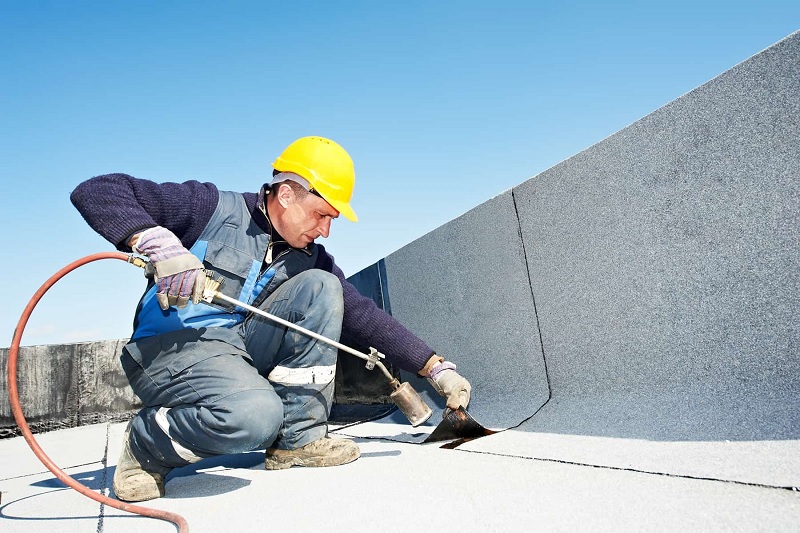Flat roofs are popular in urban areas and known for their clean lines and minimalist appeal. However, their structure can make them vulnerable to specific issues, requiring prompt attention during emergencies. When unexpected roof damage arises, these repairs are crucial to minimize further intrusion of elements and potential structural damage.
Identifying common repairs and understanding the basic techniques is essential—especially when emergencies strike. With the right knowledge and tools, you can effectively manage such situations, maintaining the integrity of your roof until more permanent solutions are viable.
Key Takeaways
- Quick, effective strategies are crucial for emergency roof repairs.
- Understanding basic repair techniques can prevent further damage.
- Employing the right materials ensures longevity and durability.
Table of Contents
- Introduction to Emergency Roof Repairs
- Recognizing Common Flat Roof Issues
- Essential Tools and Materials for Quick Fixes
- Step-by-Step Emergency Repair Techniques
- Preventive Measures for Future Problems
- Professional vs. DIY: When to Call the Experts
- Understanding Insurance Implications
- Conclusion
Introduction to Emergency Roof Repairs
Flat roofs boast a modern look and space efficiency but pose unique challenges in maintaining their integrity. When adverse weather strikes or wear and tear allows leaks, swift action is critical to minimizing damage. These roofs might seem simple, but their horizontal design can allow problems to creep up unexpectedly, making prompt intervention imperative to prevent escalation. Equipping yourself with the right skills and knowledge can make these overwhelming situations manageable, ensuring peace of mind and safeguarding your living or working space from the elements. Knowing the right strategies for emergency flat roof repair can save your roof from further damage and protect your home’s interior.
Recognizing Common Flat Roof Issues
Typical issues plaguing flat roofs include leaks caused by ponding water, blisters due to trapped moisture, and membrane shrinkage. These problems are exacerbated by extreme weather conditions or insufficient maintenance. Identifying these signs early, such as discoloration or structural irregularities, can prevent extensive repair work. Regular inspections aid in catching potential problems before they escalate, serving as a proactive measure to extend the roof’s lifespan and maintain efficiency.
Essential Tools and Materials for Quick Fixes
Having a toolkit ready is vital for addressing sudden roof emergencies. Essentials include roofing cement, patch kits, water-resistant spray, and tarpaulins. A quality roofing knife for precision work is a must. These tools can stabilize the damage until professional help arrives. Roofing repair materials should be appropriately stored, ensuring they’re in good condition when an emergency strikes, as degraded supplies can worsen existing problems. With the right materials, temporary repairs can be executed effectively, buying precious time to plan a permanent solution. A sturdy ladder is necessary for safe roof access, safety harnesses, and non-slip footwear. A pry bar and hammer can help remove damaged roofing materials. Measuring tools, like tape measure and ruler, help ensure accurate cuts and installations. It’s also essential to have a caulk gun for applying sealant to joints and seams. Personal protective equipment, such as gloves, safety glasses, and a dust mask, should always be worn to prevent injuries. With these essential tools and materials, you can quickly and effectively address minor roof emergencies and prevent further damage.
Step-by-Step Emergency Repair Techniques
- Locate the Damage:Examine your roof to identify signs of distress. This initial inspection is crucial for determining the next steps in the repair process, as the nature and extent of the damage will guide the necessary actions.
- Clean the Area:Clear accumulated debris and standing water to access the damaged zone. Proper cleaning prevents additional water pooling and prepares the area for repair application, ensuring the patchwork adheres correctly and lasts longer.
- Apply a Patch or Cement:Use roofing cement or a patch kit to seal and protect against further leakage. Properly applied materials can withstand further temporary exposure to the elements, protecting the internal structures until comprehensive repairs can be performed.
- Secure the Repair:Firmly place and seal the patch to withstand upcoming weather conditions. Minor environmental challenges can test the durability of this initial fix, so it’s essential to ensure any temporary solutions are robust and properly adhered to.
- Monitor the Repair:Check regularly for signs of deterioration until a permanent fix is implemented. Periodically observing the area helps gauge the performance of the interim repair and plan timely interventions if needed.
Preventive Measures for Future Problems
Routine maintenance can avert common emergencies; inspecting at least twice a year is recommended. Maintaining cleanliness on the roof and drainage systems helps avoid buildups that could cause leaks or structural damage. Quality materials and professional installation can significantly extend your roof’s lifespan. Proactive measures like these reduce the likelihood of encountering unexpected repairs and help ensure that your roof stands the test of time. Regular inspections can help identify any developing issues before they become significant problems, like small cracks or loose shingles. Cleaning gutters and downspouts prevents water from accumulating on the roof, which can lead to leaks and structural damage. Trimming overhanging trees can prevent branches from falling on the roof and causing damage. Applying a protective coating to the roof can help seal it and protect it from the elements. Keeping records of all maintenance and repairs can help you track the condition of your roof and identify any recurring problems. By taking these preventive measures, you can extend the life of your roof and reduce the need for emergency repairs.
Professional vs. DIY: When to Call the Experts
Although minor repairs may seem approachable, the line between a DIY fix and necessary professional intervention is thin. Assess the scope of damage and consult this handy guide to determine when to bring in specialists. Complex issues often require expert handling to ensure safety, prevent future damage, and uphold the warranty of your roofing materials. Leaving severe repairs in qualified hands protects your investment in your roof, guaranteeing any actions taken are up to industry standards and tailoring solutions specific to your needs. Hiring a professional is always the best course of action for significant leaks, structural damage, or extensive repairs. Attempting to repair complex roofing problems without the proper knowledge and experience can be dangerous and even void your roof’s warranty. Professionals have the right tools, training, and experience to safely and effectively repair any roof. They can also identify underlying issues that you may not be able to see and provide long-term solutions to prevent future problems. While DIY repairs may seem cost-effective, they can cost you more in the long run if they are not done correctly.
Understanding Insurance Implications
Navigating insurance policies can be daunting, but understanding your coverage can mitigate financial stress during emergencies. Thorough documentation and prompt communication with your provider streamline the claims process, potentially covering repair costs. Being informed about what your policy includes and excludes helps you leverage its benefits fully, allowing for strategic planning when budgeting for repairs or replacements. Reviewing your policy annually can ensure you have the right coverage in place. Document damage by taking photos and videos before making any repairs. Contact your insurance company as soon as possible after discovering damage. Provide your insurance company with all the necessary information, including the date of damage, description of the damage, and estimated cost of repairs. Working with a reputable roofing contractor familiar with insurance claims can also help streamline the process. Understand policy limitations and conditions and what factors will prevent you from receiving reimbursement for damages. A thorough understanding of your insurance coverage is essential for peace of mind and managing repairs effectively. Please keep copies of relevant documents, including the policy, photos, and communications with your insurer. Consult with a legal professional or public adjuster to ensure that your claim is fairly assessed. Know your rights as a policyholder and ensure that your insurance company adheres to fair claim settlement practices.
Conclusion
Emergency flat roof repairs require vigilance, appropriate techniques, and timely decisions to be effective. By equipping yourself with the necessary knowledge and tools and knowing when to seek expert help, you can effectively safeguard your home against further deterioration. Regular maintenance and an understanding of preventive care ensure your flat roof remains durable, offering peace of mind and security against the unexpected. Proactive measures combined with informed decision-making lay the groundwork for a robust, enduring, resilient roof through the years. The longer the problem persists, the more damage will be caused. Understanding the nuances of flat roof repair is essential for every homeowner or property manager. Making timely decisions and taking appropriate action will prevent any further deterioration. Routine inspections and a proactive approach form a resilient roof system. The safety of your home is enhanced through this strategy. Your home is not only protected but its value is also preserved. Always prioritize safety when dealing with roof repairs. By investing in preventative maintenance, you’re choosing savings in the long run and avoiding expensive emergencies. Remember, a well-maintained flat roof protects your property and contributes to its overall aesthetic appeal. Regularly check for signs of wear and tear, and address them promptly. Consider enlisting the help of a qualified roofing contractor for regular inspections and maintenance. Educating yourself about flat roof systems will help you make informed decisions. Your flat roof can provide years of reliable service and protection with proper care and attention.

